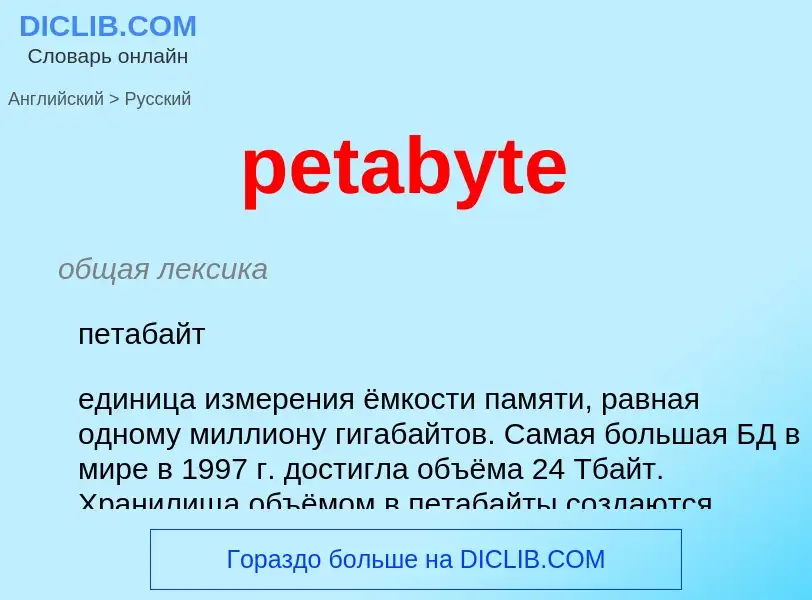Traducción y análisis de palabras por inteligencia artificial ChatGPT
En esta página puede obtener un análisis detallado de una palabra o frase, producido utilizando la mejor tecnología de inteligencia artificial hasta la fecha:
- cómo se usa la palabra
- frecuencia de uso
- se utiliza con más frecuencia en el habla oral o escrita
- opciones de traducción
- ejemplos de uso (varias frases con traducción)
- etimología
petabyte - traducción al ruso
общая лексика
петабайт
единица измерения ёмкости памяти, равная одному миллиону гигабайтов. Самая большая БД в мире в 1997 г. достигла объёма 24 Тбайт. Хранилища объёмом в петабайты создаются телекомпаниями для видеоархивов
синоним
Смотрите также
общая лексика
септибайт
единица ёмкости памяти, равная 1024 секстибайт (zettabyte), или 280 1 208 925 819 614 629 174 706 176 байт
синоним
Смотрите также
Definición
Wikipedia
The byte is a unit of digital information that most commonly consists of eight bits. Historically, the byte was the number of bits used to encode a single character of text in a computer and for this reason it is the smallest addressable unit of memory in many computer architectures. To disambiguate arbitrarily sized bytes from the common 8-bit definition, network protocol documents such as the Internet Protocol (RFC 791) refer to an 8-bit byte as an octet. Those bits in an octet are usually counted with numbering from 0 to 7 or 7 to 0 depending on the bit endianness. The first bit is number 0, making the eighth bit number 7.
The size of the byte has historically been hardware-dependent and no definitive standards existed that mandated the size. Sizes from 1 to 48 bits have been used. The six-bit character code was an often-used implementation in early encoding systems, and computers using six-bit and nine-bit bytes were common in the 1960s. These systems often had memory words of 12, 18, 24, 30, 36, 48, or 60 bits, corresponding to 2, 3, 4, 5, 6, 8, or 10 six-bit bytes. In this era, bit groupings in the instruction stream were often referred to as syllables or slab, before the term byte became common.
The modern de facto standard of eight bits, as documented in ISO/IEC 2382-1:1993, is a convenient power of two permitting the binary-encoded values 0 through 255 for one byte—2 to the power of 8 is 256. The international standard IEC 80000-13 codified this common meaning. Many types of applications use information representable in eight or fewer bits and processor designers commonly optimize for this usage. The popularity of major commercial computing architectures has aided in the ubiquitous acceptance of the 8-bit byte. Modern architectures typically use 32- or 64-bit words, built of four or eight bytes, respectively.
The unit symbol for the byte was designated as the upper-case letter B by the International Electrotechnical Commission (IEC) and Institute of Electrical and Electronics Engineers (IEEE). Internationally, the unit octet, symbol o, explicitly defines a sequence of eight bits, eliminating the potential ambiguity of the term "byte".

